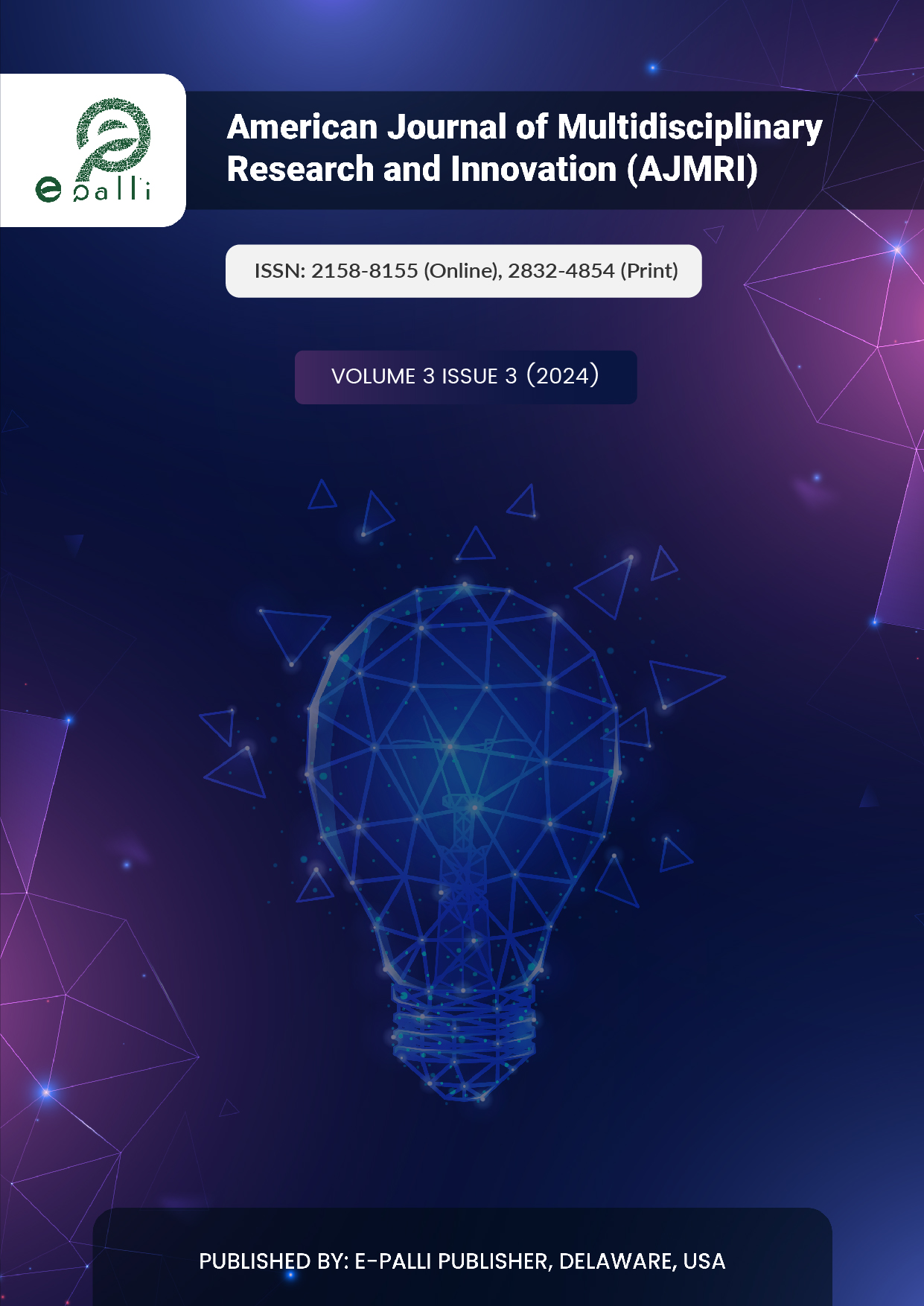A Bitcoin Conscience: Dispositional Experiences of Nepalese Users
DOI:
https://doi.org/10.54536/ajmri.v3i3.2608Keywords:
Cryptocurrency, Behavioral Intention, TAM, Perceived Risk, TrustAbstract
The purpose of this study is to explore the behavioral intention (BI) of Nepalese cryptocurrency users. Perceived ease of use and perceived usefulness are the constructs from the technology acceptance model; similarly, the trust and the perceived risk are integrated constructs based on literature to predict BI. A close-ended questionnaire survey was a five-point Likert scale. Non-probabilistic purposive sampling , 272 valid responses were analyzed using the statistical package for the social science software, which included Pearson correlation and multiple regression. The result reveals that perceived usefulness, trust, and perceived risk are the significant predictors of BI, however insignificant in relation to perceived ease of use. While consumers have shown positive behavioral intentions toward cryptocurrency, the government has insisted that the restriction is in effect. So, there seems to be a conflict between the practicability of government and the psychology of users. To cope with this, policymakers need to conduct real practice-based studies.
Downloads
References
Abbasi, G. A., Tiew, L. Y., Tang, J., Goh, Y.-N., & Thurasamy, R. (2021). The adoption of cryptocurrency as a disruptive force: Deep learning-based dual stage structural equation modelling and artificial neural network analysis. Plos one, 16(3), e0247582. https://doi.org/10.1371/JOURNAL.PONE.0247582
Adhikari, N. (2023). Police arrest five individuals involved in illegal online gambling and cryptocurrency trading Nepal Live Today. https://www.nepallivetoday.com/2023/06/14/police-arrest-five-individuals-involved-in-illegal-online-gambling-and-cryptocurrency-trading/
Alfadda, H. A., & Mahdi, H. S. (2021). Measuring students’ use of zoom application in language course based on the technology acceptance model (TAM). Journal of Psycholinguistic Research, 50(4), 883-900. https://doi.org/10.1007/S10936-020-09752-1
Almeida, J., & Gonçalves, T. C. (2023). A Decade of Cryptocurrency Investment Literature: A Cluster-Based Systematic Analysis. International Journal of Financial Studies, 11(2), 71. https://doi.org/10.3390/ijfs11020071
Altaf, A., Iqbal, F., Latif, R., Yakubu, B. M., Latif, S., & Samiullah, H. (2023). A survey of blockchain technology: Architecture, applied domains, platforms, and security threats. Social Science Computer Review, 41(5), 1941-1962. https://doi.org/10.1177/08944393221110148
BenSaïda, A. (2023). The linkage between Bitcoin and foreign exchanges in developed and emerging markets. Financial Innovation, 9(1), 38. https://doi.org/10.1186/s40854-023-00454-w
Chawla, D., & Joshi, H. (2019). Consumer attitude and intention to adopt mobile wallet in India–An empirical study. International Journal of Bank Marketing, 37(7), 1590-1618. https://doi.org/10.1108/IJBM-09-2018-0256
Cristofaro, M., Giardino, P. L., Misra, S., Pham, Q. T., & Phan, H. H. (2022). Behavior or culture? Investigating the use of cryptocurrencies for electronic commerce across the USA and China. Management Research Review(ahead-of-print). https://doi.org/10.1108/mrr-06-2021-0493
Dag, A., Dag, A. Z., Asilkalkan, A., Simsek, S., & Delen, D. (2023). A Tree Augmented Naïve Bayes-based methodology for classifying cryptocurrency trends. Journal of Business Research, 156, 113522. https://doi.org/10.1016/j.jbusres.2022.113522
Davis, F. D. (1987). User acceptance of information systems: the technology acceptance model (TAM).
Davis, F. D. (1989). Perceived usefulness, perceived ease of use, and user acceptance of information technology. MIS quarterly, 319-340. https://doi.org/10.2307/249008
Davis, F. D. (1993). User acceptance of information technology: system characteristics, user perceptions and behavioral impacts. International journal of man-machine studies, 38(3), 475-487. https://doi.org/10.1006/imms.1993.1022
Fu, S., Yan, Q., & Feng, G. C. (2018). Who will attract you? Similarity effect among users on online purchase intention of movie tickets in the social shopping context. International journal of information management, 40, 88-102. https://doi.org/10.1016/j.ijinfomgt.2018.01.013
Ghimire, D. (2023). Cryptocurrency in Nepal: Regulation, Not Prohibition. https://samriddhi.org/blog/cryptocurrency-in-nepal-regulation-not-prohibition/
Hameed, F., Qayyum, A., & Khan, F. A. (2022). A new trend of learning and teaching: Behavioral intention towards mobile learning. Journal of Computers in Education, 1-32. https://doi.org/10.1007/s40692-022-00252-w
Hang, B. T. T., Huy, D. T. N., An, P. T., Ngoc, N. T. B., & Duyen, H. T. M. (2020). Current situation of Bitcoin management and use: perspectives from the world and recommendations for vietnam. Management, 209-235.
Hayes, A. F., & Coutts, J. J. (2020). Use omega rather than Cronbach’s alpha for estimating reliability. But…. Communication Methods and Measures, 14(1), 1-24. https://doi.org/10.1080/19312458.2020.1718629
Huang, C.-K., Lee, N. C.-A., & Chen, W.-C. (2023). Dilemmatic dual-factor determinants of discontinuous intention in cryptocurrency usage. Information Technology & People, 36(2), 564-594. https://doi.org/10.1108/itp-11-2020-0778
Ishfaq, N., & Mengxing, H. (2021). Consumer usage behavior of internet-based services (IBS) in Pakistan during COVID-19 crisis from the perspective of technology acceptance model. Environmental Science and Pollution Research, 1-16. https://doi.org/10.1007/S11356-021-15868-1
Khadka, R. (2022). Nepal, which has banned cryptocurrency, watches closely as India announces to introduce one. My Republica. https://myrepublica.nagariknetwork.com/news/nepal-which-has-banned-cryptocurrency-watches-closely-as-india-announces-to-introduce-one/
Krichen, M., Ammi, M., Mihoub, A., & Almutiq, M. (2022). Blockchain for modern applications: A survey. Sensors, 22(14), 5274. https://doi.org/10.1109/ACCESS.2020.2967218
Liu, N., & Ye, Z. (2021). Empirical research on the blockchain adoption–based on TAM. Applied Economics, 53(37), 4263-4275. https://doi.org/10.1080/00036846.2021.1898535
Marikyan, D., Papagiannidis, S., & Stewart, G. (2023). Technology acceptance research: Meta-analysis. Journal of Information Science, 01655515231191177. https://doi.org/10.1177/01655515231191177
Maurer, B., Nelms, T. C., & Swartz, L. (2013). “When perhaps the real problem is money itself!”: the practical materiality of Bitcoin. Social semiotics, 23(2), 261-277.
Namahoot, K. S., & Rattanawiboonsom, V. (2022). Integration of TAM Model of Consumers’ Intention to Adopt Cryptocurrency Platform in Thailand: The Mediating Role of Attitude and Perceived Risk. Human Behavior and Emerging Technologies, 2022. https://doi.org/10.1155/2022/9642998
Nuryyev, G., Wang, Y.-P., Achyldurdyyeva, J., Jaw, B.-S., Yeh, Y.-S., Lin, H.-T., & Wu, L.-F. (2020). Blockchain technology adoption behavior and sustainability of the business in tourism and hospitality SMEs: An empirical study. Sustainability, 12(3), 1256. https://doi.org/10.3390/su12031256
Ooi, S. K., Ooi, C. A., Yeap, J. A., & Goh, T. H. (2021). Embracing Bitcoin: users’ perceived security and trust. Quality & Quantity, 55, 1219-1237. https://doi.org/10.1007/S11135-020-01055-W
Pal, A., Herath, T., De’, R., & Rao, H. R. (2021). Is the convenience worth the risk? An investigation of mobile payment usage. Information Systems Frontiers, 23, 941-961.
Peng, R., Xiong, L., & Yang, Z. (2012). Exploring tourist adoption of tourism mobile payment: An empirical analysis. Journal of theoretical and applied electronic commerce research, 7(1), 21-33. https://doi.org/10.4067/S0718-18762012000100003
Quan, W., Moon, H., Kim, S. S., & Han, H. (2023). Mobile, traditional, and cryptocurrency payments influence consumer trust, attitude, and destination choice: Chinese versus Koreans. International Journal of Hospitality Management, 108, 103363. https://doi.org/10.1016/j.ijhm.2022.103363
Renduchintala, T., Alfauri, H., Yang, Z., Pietro, R. D., & Jain, R. (2022). A survey of blockchain applications in the fintech sector. Journal of Open Innovation: Technology, Market, and Complexity, 8(4), 185. https://doi.org/10.3390/joitmc8040185
Saxena, R., Arora, D., Nagar, V., & Mahapatra, S. (2021). Bitcoin: a digital cryptocurrency. In Blockchain Technology: Applications and Challenges (pp. 13-28). Springer. https://doi.org/10.1007/978-3-030-69395-4
Sharma, A., & Gandhi, A. V. (2023). Consumer adoption study for innovative technology products and services in an emerging economy. International Journal of Innovation Science. https://doi.org/10.1108/ijis-06-2022-0106
Shin, D., & Bianco, W. T. (2020). In blockchain we trust: does blockchain itself generate trust? Social Science Quarterly, 101(7), 2522-2538. https://doi.org/10.1111/ssqu.12917
Singh, S., Sahni, M. M., & Kovid, R. K. (2020). What drives FinTech adoption? A multi-method evaluation using an adapted technology acceptance model. Management decision, 58(8), 1675-1697. https://doi.org/10.1108/MD-09-2019-1318
Song, Y., Chen, B., & Wang, X.-Y. (2023). Cryptocurrency technology revolution: are Bitcoin prices and terrorist attacks related? Financial Innovation, 9(1), 1-20.
Sprenger, D. A., & Schwaninger, A. (2023). Video demonstrations can predict the intention to use digital learning technologies. British Journal of Educational Technology, 54(4), 857-877. https://doi.org/10.1111/bjet.13298
Ter Ji-Xi, J., Salamzadeh, Y., & Teoh, A. P. (2021). Behavioral intention to use cryptocurrency in Malaysia: an empirical study. The Bottom Line, 34(2), 170-197. https://doi.org/10.1108/BL-08-2020-0053
Thommandru, A., & Chakka, B. (2023). Recalibrating the Banking Sector with Blockchain Technology for Effective Anti-Money Laundering Compliances by Banks. Sustainable Futures, 5, 100107. https://doi.org/10.1016/j.sftr.2023.100107
Wei, X., Peng, X., & Prybutok, V. (2022). Consumer behavioral intention of adopting emerging healthcare technology. IEEE Transactions on Engineering Management. https://doi.org/10.1109/tem.2022.3140952
Zhang, W., Siyal, S., Riaz, S., Ahmad, R., Hilmi, M. F., & Li, Z. (2023). Data Security, Customer Trust and Intention for Adoption of Fintech Services: An Empirical Analysis From Commercial Bank Users in Pakistan. SAGE Open, 13(3), 21582440231181388. https://doi.org/10.1177/21582440231181388
Zhou, Q., Huang, H., Zheng, Z., & Bian, J. (2020). Solutions to scalability of blockchain: A survey. Ieee Access, 8, 16440-16455. https://doi.org/10.1109/ACCESS.2020.2967218
Downloads
Published
How to Cite
Issue
Section
License
Copyright (c) 2024 Ujjwal Adhikari, Santosh Gyawali

This work is licensed under a Creative Commons Attribution 4.0 International License.







